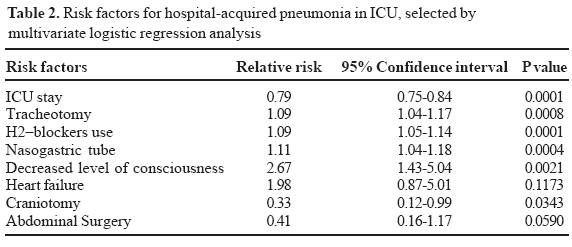Pneumonia is the most frequent hospital infection in patients admitted to intensive care units (ICU) and is also responsible for the highest lethality rates, as well as an increase in both the duration and costs of hospitalization. The objective of this study was to identify predisposing factors for pneumonia. A prospective cohort study was carried out between June 1996 and June 1997, and included 540 patients admitted consecutively for periods greater than 24 hours to the adult ICU of the Londrina State University's Teaching Hospital. Of these, 83 (15.4%) developed pneumonia. All patients were analyzed with respect to various risk factors for hospital-acquired pneumonia. Univariate analysis identified the following factors: decreased level of consciousness, craniotomy, prior use of antibiotics, mechanical ventilation, nasogastric tube feeding, enteral feeding, aspiration of gastric contents, central venous catheter and the time spent in the ICU. Multivariate analysis identified four risk factors for pneumonia in the ICU: tracheotomy (RR = 1.09; 95%CI = 1.04-1.17), nasogastric tube feeding (RR = 1.11; 95%CI = 1.05-1.18), H2-blocker use (RR = 1.09; 95%CI = 1.05-1.14) and decreased level of consciousness (RR = 2.67; 95%CI = 1.43-5.04). In 56.6% of patients, pneumonia occurred within the first four days following ICU admission. The risk factors identified were all necessary for the treatment of the patient except for decreased level of consciousness, either present at admission or occurring during hospitalization due to deterioration in the clinical condition of the patient or to the use of sedatives.
Pneumonia; epidemiology; risk factors






